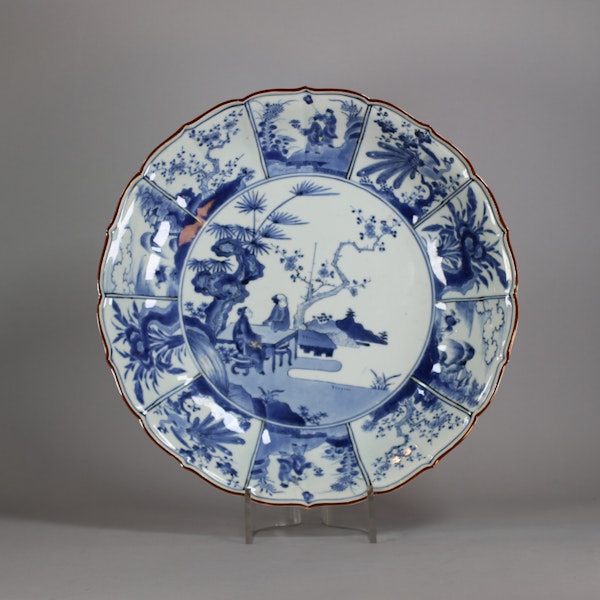Japanese Kakiemon-style moulded dish Edo period, circa 1680
Japanese Kakiemon-style moulded dish Edo period, circa 1680
POA
Description
Japanese Kakiemon-style moulded dish Edo period, circa 1680, painted in a bright underglaze blue, the centre with a fantasy scene of a couple at a table under rockwork and shrubs besides a lake, mountains and a house in the distance, the foliate-shape rim in chocolate, the rim band with alternating variously decorated panels; including people and shrubs; the underneath with a Fuku mark.
Condition: small glaze flaw to the front.Japanese Kakiemon-style moulded dish, Edo period, c.1680, painted in bright underglaze blue, the centre with a scene of a couple seated at a table, with bamboo and plum emerging from rockwork beside them as they look out over a lake, with mountains and a house in the distance, the wide rim-band with ten alternating panels containing scenes of people in landscapes, plants and mythical hoho birds, the underside with a fuku mark, diameter: 34 cm., (13 3/8 in.), condition: small glaze flaw to the front.
Plum and bamboo comprise two of the 'friends of winter', plants which do not wither during the cold, dark winter months and instead remain green and verdant, thus representing perseverance and steadfastness through difficult times. Although this imagery originated in China, the symbolism became highly popular in Japan, and was used in artworks and ceramic designs both for domestic consumption and export. In this example, the appearance of the friends of winter alongside a couple represents constancy within a relationship: unlike the pretty but fleeting blossom of the springtime, a true connection is one which endures even through the most testing times. That only two of the three friends are included is part of a wider theme of repeated pairs on the dish: the couple sitting at the table, the two friends picking flowers in one of the smaller panels, and the repetition of each small vignette around the rim, with each scene, much like the central couple, facing its fellow counterpart. The fuku mark on the base translates to 'happiness', and the united imagery of the dish represents the felicity of a steadfast relationship
https://www.chinese-porcelain-art.com/item/W297/japanese-kakiemon-style-moulded-dish-edo-period-circa-1680/
| item details | |
|---|---|
| Material and Technique | Porcelain decorated with underglaze cobalt blue |
| Origin | Japanese |
| Period | 17th Century |
| Condition | Excellent |
| Diameter | 34 cm., (13 3/8 in.) |
Product REF: W297




